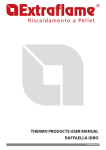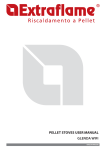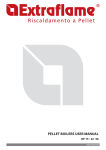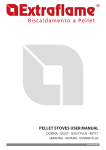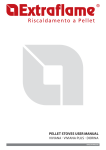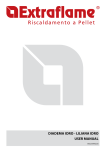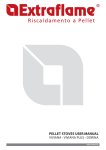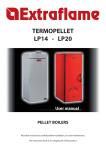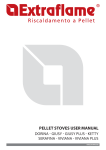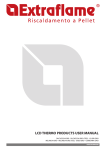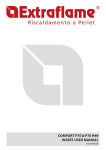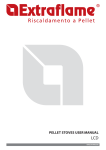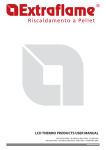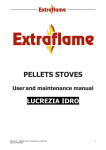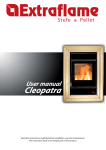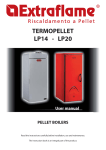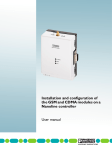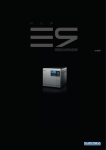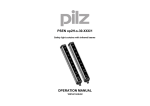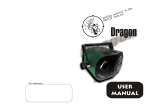Download MELINDA IDRO THERMO PRODUCTS USER MANUAL
Transcript
THERMO PRODUCTS USER MANUAL
MELINDA IDRO
ENGLISH/INGLESE
2
ENGLISH
ENGLISH....................................................................................................................................................................................... 4
Warnings................................................................................................................................................................................... 4
Safety......................................................................................................................................................................................... 4
Routine Maintenance........................................................................................................................................................... 4
HYDRAULIC SYSTEM................................................................................................................................................................... 5
Installation and safety devices................................................................................................................................................................................. 5
Anti-condensation DEVICE (mandatory)....................................................................................................................... 5
Instant domestic hot water production kit.............................................................................................................. 6
Stove positioning................................................................................................................................................................................................................... 6
REARMING................................................................................................................................................................................... 6
THERMO-PRODUCTS FEATURES............................................................................................................................................... 6
INSTALLATION............................................................................................................................................................................. 7
General.......................................................................................................................................................................................................................................... 7
Pellets and feeding.............................................................................................................................................................. 9
CHECKS AND PRECAUTIONS FOR FIRST IGNITION................................................................................................................. 9
THE PELLET LOADING MOTOR DOES NOT WORK:................................................................................................................................................... 9
BULB THERMOSTATS - RESET:.................................................................................................................................................................................................. 9
Control panel.......................................................................................................................................................................10
Display icons key...................................................................................................................................................................................................................10
General menu..........................................................................................................................................................................................................................11
Basic instructions ..............................................................................................................................................................................................................11
THE REMOTE CONTROL............................................................................................................................................................12
Enable delayed switch-off............................................................................................................................................................................................12
Type and replacement of batteries.........................................................................................................................................................................12
COMMISSIONING settings....................................................................................................................................................13
Mains frequency 50/ 60Hz................................................................................................................................................................................................13
Adjusting time, day, month and year......................................................................................................................................................................13
Adjusting language...........................................................................................................................................................................................................13
Other functions...................................................................................................................................................................13
Air discharge...........................................................................................................................................................................................................................13
FIRST LOAD....................................................................................................................................................................................................................................13
Operation and logic...........................................................................................................................................................14
Additional thermostat.....................................................................................................................................................15
Additional thermostat functioning with stby active.............................................................................................................................15
Additional thermostat functioning with stby deactivated...............................................................................................................15
Additional thermostat installation.....................................................................................................................................................................15
Set power................................................................................................................................................................................16
TEMPERATURE set...................................................................................................................................................................16
USER MENU...............................................................................................................................................................................16
Enable fan..................................................................................................................................................................................................................................16
V1- Air.............................................................................................................................................................................................................................................16
reset...............................................................................................................................................................................................................................................17
low..................................................................................................................................................................................................................................................17
SET CHRONO.............................................................................................................................................................................17
STATUS.......................................................................................................................................................................................18
Settings...................................................................................................................................................................................18
set clock ....................................................................................................................................................................................................................................18
Adjusting language...........................................................................................................................................................................................................18
Display..........................................................................................................................................................................................................................................18
stand - by.....................................................................................................................................................................................................................................19
aux.............................................................................................................................................................................................19
Cleaning and maintenance..............................................................................................................................................20
Routine maintenance carried out by authorised technicians ........................................................................22
Putting the equipment out of service (end of the season)...................................................................................................................22
Displays...................................................................................................................................................................................24
ALARMS.....................................................................................................................................................................................24
ENGLISH
3
We thank you for having chosen our company; our product is a great heating solution developed from the
most advanced technology with top quality machining and modern design, aimed at making you enjoy
the fantastic sensation that the heat of a flame gives, in complete safety.
Warnings
This instructions manual is an integral part of the product: make sure that it always accompanies the appliance, even if transferred to another
owner or user, or if transferred to another place. If it is damaged or lost, request another copy from the area technician. This product is
intended for the use for which it has been expressly designed. The manufacturer is exempt from any liability, contractual and extracontractual,
for injury/damage caused to persons/animals and objects, due to installation, adjustment and maintenance errors and improper use.
Installation must be performed by qualified staff, which assumes complete responsibility for the definitive installation and
consequent good functioning of the product installed. One must also bear in mind all laws and national, regional, provincial and
town council Standards present in the country in which the appliance has been installed, as well as the instructions contained in this
manual.
The Manufacturer cannot be held responsible for the failure to comply with such precautions.
After removing the packaging, ensure that the content is intact and complete. Otherwise, contact the dealer where the appliance was
purchased.
All electric components that make up the product must be replaced with original spare parts exclusively by an authorised after-sales centre,
thus guaranteeing correct functioning.
Safety
The generator must not be used by persons (including children) with reduced physical, sensory and
mental capacities or who are unskilled persons, unless they are supervised and trained regarding use
of the appliance by a person responsible for their safety.
Children must be checked to ensure that they do not play with the appliance.
Do not touch the generator when you are barefoot or when parts of the body are wet or damp.
The safety and adjustment devices must not be modified without the authorisation or indications
of the manufacturer.
Do not pull, disconnect, twist electric cables leaving the stove, even if disconnected from the
electric power supply mains.
It is advised to position the power supply cable so that it does not come into contact with hot parts
of the appliance.
The power supply plug must be accessible after installation.
Do not close or reduce the dimensions of the airing vents in the place of installation. The airing
vents are essential for correct combustion.
Do not leave the packaging elements within reach of children or unassisted disabled persons.
The hearth door must always be closed during normal functioning of the product.
When the appliance is functioning and hot to the touch, especially all external surfaces, attention
must be paid
Check for the presence of any obstructions before switching the appliance on following a
prolonged period of inactivity.
The generator has been designed to function in any climatic condition. In particularly adverse
conditions (strong wind, freezing) safety systems may intervene that switch the generator off. If this
occurs, contact the technical after-sales service and always disable the safety systems.
In the event the flue catches fire, use suitable systems for suffocating the flames or request help
from the fire brigade.
This appliance must not be used to burn waste
Do not use any flammable liquids for ignition
During the filling phase do not put the bag of pellets to into contact with the product
The majolicas are top quality artisan products and as such can have micro-dots, crackles and
chromatic imperfections. These features highlight their valuable nature. Due to their different dilation
coefficient, they produce crackling, which demonstrate their effective authenticity. To clean the
majolicas, it is recommended to use a soft, dry cloth. If a detergent or liquid is used, the latter could
penetrate inside the crackles, highlighting them.
Routine Maintenance
Based on Decree 22 January 2008 n°37 art.2, routine maintenance means interventions aimed at reducing degradation due to normal use,
as well as dealing with accidental events entailing the need of first interventions, which however do not modify the structure of the system
upon which one is intervening or its intended use according to the requirements laid down by the technical standards in force and by the
manufacturer's use and maintenance manual.
4
ENGLISH
HYDRAULIC SYSTEM
Certain concepts referring to the Italian Standard UNI 10412-2 (2009) are described in this chapter.
As previously described, when installing, all national, regional, provincial and council Standards in force provided by the country in which the
appliance has been installed must be complied with.
During installation of the generator it is MANDATORY to adjust the system with a manometer in order to display the water pressure.
Table of the devices for closed vessel systems present and not present in the product
Safety valve
Pump control thermostat (it is controlled by the water probe and the board program)
Acoustic alarm activation thermostat
Water temperature indicator (display)
Pressure transducer with view on the display
Acoustic alarm
Automatic adjustment circuit breaker switch (managed by board program)
Pressure transducer with minimum and maximum pressure switch alarm
Water overheating automatic circuit breaker switch (block thermostat)
Circulation system (pump)
Expansion system
p
p
p
p
p
p
p
p
p
Installation and safety devices
The installation, relative system connections, commissioning and inspection of correct functioning must be carried out with the highest
professional standards, in full compliance with the national, regional and council Standards in force, as well as these instructions. For Italy,
installation must be carried out by professionally authorised staff (Ministerial Decree dated 22.01.08 n°37).
The Manufacturer declines all liability for damage/injury to objects/persons caused by the plant.
Type of system
There are 2 different types of system:
Open vessel system and closed vessel system.
The product has been designed and made to work with closed vessel systems.
Check that the preload of the expansion vessel is set to 1.5 bar.
Safety devices for closed vessel system
According to Standard UNI 10412-2 (2009)in force in Italy, closed systems must be equipped with: safety valve, pump control thermostat,
acoustic alarm activation thermostat, temperature indicator, pressure indicator, acoustic alarm, regulation automatic circuit breaker switch,
automatic circuit breaker block switch (block thermostat), circulation system, expansion system, safety dissipation system incorporated with
the generator with thermal safety valve (self-activated), whenever the appliance does not have a temperature self-adjustment system.
Distances of safety devices according to the Standard
The temperature safety sensors must be in place on the machine at a distance no greater than 30 cm from the flow connection. Whenever the
generators lack a device, those missing can be installed on the generator flow pipe, within a distance no greater than 1 m from the machine.
Commissioning checks
Before connecting the boiler:
a) wash all system piping thoroughly in order to remove any residues which might compromise the correct functioning of certain system
components (pumps, valves, etc.).
b) check to verify that the flue has adequate draught, that it is not narrowed and that other appliances do not discharge into the flue. This is to
prevent unexpected power increases. The flue fitting can be mounted between the boiler and the flue only after this inspection. An inspection
of the connections with pre-existing flues is recommended.
Anti-condensation DEVICE (mandatory)
Make sure a suitable anti-condensate circuit has been realised, which guarantees an appliance return temperature of at least 55°C. The
automatic thermostatic valve, for instance, is used in solid fuel boilers as it prevents cold water from returning into the exchanger. A high
return temperature allows efficiency improvement, reduces formation of smoke condensation and prolongs the generator's life span. The
manufacturer recommends using the 55°C model with 1'' hydraulic connections.
Valve sold as an accessory (optional)
ENGLISH
5
Instant domestic hot water production kit
Warnings: if the instant hot water production kit is to be used, contact the company technical after-sales service.
Stove positioning
For correct product functioning, it is recommended to position it in a way that it is perfectly level, with the aid of a spirit level.
REARMING
The figures below show the positions for rearming the tank (85°C) and H2O (100°C).
We recommend contacting a qualified technician in the event rearming occurs to verify its cause.
85°c
100°C
Melinda Idro
THERMO-PRODUCTS FEATURES
Water content of the thermo product heat exchanger (l)
Volume of expansion vessel integrated into thermo-product (l)
Maximum content of water in the system for integrated expansion vessel (l)*
3 bar safety valve integrated into the thermo-product
Minimum and maximum pressure switch integrated into the thermo-product
Pump integrated into the thermo-product
Pump max. head (m)
13
6
23
YES
YES
YES
6
7
6
5
Head (m)
*Content of water in the system in addition to that of the thermo
product that can be managed with the integrated expansion
vessel. An additional expansion vessel must be installed for a
higher content of water.
The following graph shows the behaviour of the circulator pump
used on our thermo-products at the speeds that can be set.
4
3
2
1
0
6
ENGLISH
0
0,5
1
1,5
2
Flow rate (m3/h)
2,5
3
3,5
INSTALLATION
General
The flue gas exhaust and hydraulic connections must be carried out by qualified personnel who must issue installation conformity
documentation compliant with national standards.
The installer must provide the owner or person acting for him, according to the legislation in force, with the declaration of conformity,
supplied with:
1) the use and maintenance manual of the appliance and of the system components (such as for example, the smoke ducts, chimney, etc.);
2) photocopy or photograph of the chimney plaque;
3) system booklet (where applicable).
The installer must ask to be issued with a receipt stating that the documentation has been provided, and must keep it with a copy of the technical
documentation relating to the installation.
For installation in a condominium, prior approval from the condominium's administrator must be requested.
COMPATIBILITY
Installation in premises with fire hazards is forbidden. Installation in residential premises (except for sealed operation appliances) is also
forbidden:
in which there are liquid fuel-operated appliances with continuous or intermittent operation, which draw the combustion air in the
room in which they are installed, or
in which there are type B gas appliances intended for room heating, with or without production of domestic hot water and in adjacent
and adjoining premises, or
in which, in any case, the depression measured during installation between the internal and external environment is greater than 4 Pa
Installations in bathrooms, bedrooms and studio flats
Installation in bathrooms, bedrooms and studio flats is only allowed for sealed or closed hearth appliances with ducted combustion air taken
from the outside.
POSITIONING AND SAFETY DISTANCES
The support surfaces and/or points must have a suitable capacity to bear the overall weight
of the appliance, accessories and coverings. If the floor is made of a combustible material,
we recommending using a non-combustible material to protect the front part from any
burnt material which might fall during routine cleaning operations.
The generator must be level to function properly.
The adjacent, side and rear walls and the supporting surface must be made of noncombustible material. Installation adjacent to combustible or heat sensitive materials is
allowed as long as there is a suitable safety distance in between, which for pellet stoves is:
REFERENCES
Inflammable objects
Non-inflammable objects
A
200 mm
100 mm
B
1500 mm
750 mm
C
200 mm
100 mm
A
B
C
Air inlet
floor protection
Installing inserts
When installing inserts, access must be prevented to the internal parts of the appliance and it must not be possible to access live parts during
extraction operations.
Any wiring, for example the power cable or room probe, must be positioned so as not to be damaged during movement of the insert and
must not come into contact with hot parts.
Ventilation and aeration of the installation premises
Ventilation is deemed sufficient when the room is equipped with air inlets according to the table:
Percentage of the
net opening section with respect to
the appliance fumes outlet section
Minimum net opening value of
the ventilation duct
Appliance categories
Reference standard
Pellet stoves
UNI EN 14785
-
80 cm²
Boilers
UNI EN 303-5
50%
100 cm²
In any case ventilation is deemed sufficient when the pressure difference between the external and internal environment is equal to or less
than 4 Pa.
ENGLISH
7
In the presence of type B gas appliances with intermittent operation not intended for heating, they must have their own aeration and/or
ventilation opening.
The air inlets must meet the following requirements:
they must be protected with grids, metal mesh, etc., but without reducing the net useful section;
they must be made so as to make the maintenance operations possible;
positioned so that they cannot be obstructed;
The clean and non-contaminated air flow can also be obtained from a room adjacent to that of installation (indirect aeration and
ventilation), as long as the flow takes place freely through permanent openings communicating with the outside.
The adjacent room cannot be used as a garage, or to store combustible material or for any other activity with a fire hazard, bathroom,
bedroom or common room of the building.
FLUE GAS EXHAUST
The heat generator works in depression and is equipped with an outlet fan for flue gas extraction. There must be a single exhaust system for
the generator. Using a flue that is shared with other devices is not allowed.
The components of the flue gas exhaust system must be chosen in relation to the type of appliance to be installed in compliance with:
UNI/ TS 11278 in the event of metal chimneys, with particular attention to that stated in the specification;
UNI EN 13063-1 and UNI EN 13063-2, UNI EN 1457, UNI EN 1806 in the event of non-metallic chimneys.
The length of the horizontal section must be minimal and, in any case, no longer than 3 metres, with a minimum upward slope of 3%
There must not be more than 4 direction changes including the one due to the use of the "T" element.
A “T” fitting with a condensation collection cap must be provided at the base of the vertical section.
If the exhaust is not inserted in an existing flue, a vertical section with a windproof end piece is required (UNI 10683).
The vertical duct can be inside or outside the building. If the smoke duct is inserted in an existing flue, it must be certified for solid fuel.
If the smoke duct is outside the building, it must always be insulated.
The smoke ducts must have at least one airtight inlet for flue gas sampling.
All the sections of the flue gas duct must be accessible to inspection.
Inspection openings must be provided for cleaning.
CHIMNEY CAP
The chimney caps must meet the following requirements:
they must have a useful outlet section no less than double that of the chimney/ducted system on which it is installed;
they must be adapted in order to prevent the penetration of rain and snow in the chimney/ducted system;
they must be built so that, in the event of winds coming from all directions and from any angle, the expulsion of combustion products
is in any case ensured;
Examples of correct connection to the chimney
Protection from rain and wind
Protection from rain
and wind
Insulated flue
Max 3 mt
3 - 5%
"T" fitting
with
inspection
plug
Condensation-proof
"T" fitting with
inspection plug
Insulated "T" fitting
with inspection
plug
Connection to the mains electric supply
The generator is supplied with an electric power cable to be plugged into a 230V 50 Hz socket, possibly with a circuit breaker switch. The
socket must be easily accessible.
The electrical system must be compliant with standards. The efficiency of the earthing circuit must be checked. Unsuitable earthing of the
system can cause malfunctioning for which the manufacturer will not be held liable.
Power supply variations beyond 10% can cause faulty operation of the product.
8
ENGLISH
Pellets and feeding
Pellets are made by applying high pressure to sawdust, or wood waste products (not containing paint) from sawmills, carpentry and other
activities related to processing and working with wood.
Given that it does not use any glue to hold it together this type of fuel is completely environmentally friendly. In fact the compactness of the
pellets over time is guaranteed by a natural substance found in the wood itself: wood coal. In addition to being an environmentally friendly
fuel in that it pushes wood residues to the limits pellets also have technical advantages.
While wood has a calorific value of 4.4kWh/kg. (with 15% humidity after around 18 months of seasoning) the calorific value of pellets is 5 kWh/
kg.
Pellet density is 650kg/m3 and the water content is equal to 8% of its weight. For this reason they do not require seasoning in order to arrive
at a sufficiently adequate degree of heat yield.
The pellets used must comply with the characteristics described by the
following standards:
EN plus - UNI EN 14961 - 2 (UNI EN ISO 17225-2) class
a1 or a2
The manufacturer always recommended using pellets with a diameter
of 6 mm with its products.
pellet STORAGE
In order to ensure problem-free combustion pellets must be stored in
a dry place.
Open the tank lid and load the pellets using a scoop.
THE USE OF EXPIRED PELLETS OR ANY OTHER MATERIAL WILL AFFECT THE FUNCTIONALITY OF YOUR
GENERATOR AND MAY LEAD TO THE TERMINATION OF THE WARRANTY AND CESSATION OF ANY ACCOMPANYING
RESPONSIBILITY ON THE PART OF THE MANUFACTURER
CHECKS AND PRECAUTIONS FOR FIRST IGNITION
IMPORTANT!
IN ORDER FOR THE GENERATOR TO WORK PROPERLY, THE HYDRAULIC SYSTEM’S PRESSURE MUST BE BETWEEN
0.6 AND 2.5 BAR.
If the pressure detected by the digital pressure switch is below 0.6 or above 2.5 bar, it triggers a boiler alarm.
Bringing the water pressure within the standard values, it is possible to reset the alarm by pressing the button /1 for 3 seconds
(The alarm can be reset only if the fumes motor has stopped and 15 minutes have elapsed from the display of the alarm)
THE PELLET LOADING MOTOR DOES NOT WORK:
Due to the filling of the system, it is normal that there is air inside the circuit.
During the 1st ignition cycle, water movement causes the displacement of air bubbles and their out-flow from the automatic vents out of the
system. This can cause the pressure to drop and activate the minimum pressure switch, which stops the motor that transports the pellets and,
therefore, the heat generator.
Vent out the system, if necessary even multiple times, to remove the air, and reload it if the pressure is too low.
It is not a malfunction, but a normal occurrence due to its filling. After filling, the plumber must always thoroughly vent the system, using the
special vents in the circuit and running the "air breather" function on the machine. (After the first ignition and with a cold machine, re-activate
the function "air breather" - see chapter "OTHER FUNCTIONS”)
BULB THERMOSTATS - RESET:
Check by pressing the reset buttons (85 - 100°C) located on the back of the appliance, before contacting a technician (see section RESET).
ENGLISH
9
Control panel
BUTTON
ON/OFF
2
Display of various
Text messages
TO ACCESS
THE Menu
1
6
4
OFF
3
5
ADJUSTMENT
OPERATING POWER
SETTING
TEMPERATURE
Display icons key
10
Indicates the receipt of the radio signal
On = during radio communication
Off = no radio communication
Flashing = serial port excluded
Indicates the stove modulation
On = the stove is working at the set power
Flashing = the power at which the stove is working is different to
the power set, the stove is modulating (for various reasons)
Indicates the presence of an alarm.
On: indicates the presence of an alarm
Off: indicates the absence of alarms
Flashing: indicates the deactivation of the depression sensor.
It indicates weekly programming functioning
Indicator on = weekly programming active
Indicator off = weekly programming disabled
Indicates the water temperature status
Off = the T° read by the probe is above the set temperature
On = the T° read by the probe is below the set temperature
Indicates the contact of the external additional thermostat
Closed contact on = the contact of the external additional
thermostat is closed.
Open contact on: the contact of the external additional thermostat
is open.
Flashing with contact closed: the contact of the external additional
thermostat is closed and the STBY function is activated
Flashing with contact open: the contact of the external additional
thermostat is open and the STBY function is activated
It indicates fumes motor operation.
Off = fumes motor disabled
On = fumes motor active
Flashing = breakdown (contact technical after-sales service)
-
It indicates tangential fan operation (where applicable)
Off = not working
On = working
Flashing = motor at minimum
-
It indicates pellet feed motor operation
Off = pellet feed motor disabled
On = pellet feed motor active
-
It indicates pump operation
Off = pump deactivated
On = pump active
Flashing = the safety device is active (H2O temperature > 85°C)
-
ENGLISH
General menu
1
2
2
6
1
6
4
OFF
3
3
Go back - exit
1
4
5
5
2
3
Parameter scrolling: next (2) ; previous (3)
4
5
Modify settings data: increase (4); decrease (5)
6
6
Set power
Confirm - access Menu
Power
Set temperature
room air temp set
set h2o
*ENABLE v1
User MENU
* air v1
Set chrono
Enable Chrono
reset
Enable prg1
Pellet %
Enable prg2
Status
**STOVE STATUS
Enable prg3
Enable prg4
Settings
set clock
start prg1
language
stop prg1
display
Monday prg1...
stand-by
...Sunday prg1
** Menu
Technician
Set prg1
Same steps for the other ones
3 time slots
* WHERE PRESENT
** RESERVED TO THE
TECHNICIAN
Basic instructions
� The following recommendations must be followed the first
times the stove is ignited:
� Faint smells may be produced due to the drying of the paints
and silicones used. Do not remain in the environment for long
periods.
� Do not touch the surfaces as they could still be unstable.
�Air the room well several times.
� The hardening of the surfaces is terminated after several
heating processes.
� This appliance must not be used to burn waste.
� Before lighting the stove, the following points must be verified:
� The hydraulic system must be completed in compliance with the
guidelines of the regulations and the manual.
� The tank must be full of pellets.
� The combustion chamber must be clean.
� The burn pot must be completely free and clean.
� Check the hermetic closure of the fire door and the ash drawer.
� Check that the power supply cable is connected correctly.
� The bipolar switch in the rear right part must be positioned on 1.
The company has an optional additional board that allows the boiler the following further functions when managing the system.
The table below indicates the various possibilities that the optional can offer.
p
p
p
p
p
p
p
p
DHW Storage Management
Puffer Management
3 heating areas
Instant DHW option
Puffer pump or 4th heating area management
Anti-legionella management for DHW storage
DHW storage chrono management
Auxiliary output management and control
ENGLISH
11
THE REMOTE CONTROL
All that can normally be implemented through the LCD can be adjusted using the remote control.
The table below provides a detailed description of the various functions:
1
2
4
6
3
7
5
9
8
11
14
10
13
12
INFO
15
16
1
On / Off
Pressing the key for three seconds, the stove will switch on or off
2
Power increase
Pressing the key will increase the operating power
3
Power decrease
Pressing the key will decrease the operating power
4
t° increase
The temperature setting can be increased by pressing this key
5
t° decrease
The set temperature can be decreased by pressing this key
6
Enable / disable
chrono
Pressing the key once will enable or disable the chrono
7
Enable delayed
switch-off
The delayed switch-off can be set by pressing this key.
For example, if the stove is set to switch-off in an hour, it shall switch-off
automatically once the set time elapses, displaying the countdown every
minute for delayed automatic shutdown.
8
Menu
This key allows the user to access the user and technical menu (the
technical menu is reserved for assistance)
9
Increase
The temperature setting can be increased by pressing this key
10
ESC key
The key allows the user to exit any program or display and returns to the
main menu without saving the data
11
Back
The key returns to the display of the various menus
Confirmation key
This key confirms the adjustments made during the user menu
programming phase
13
Forward
The key allows the user to go forward in the various menus
14
Enable function F1
Pre-set key for future applications
15
Decrease
The key decreases the value to be set
16
Stove status
Pressing this key will display the general status of the stove
12
Important note: the numbers shown on the remote control are purely indicative and are not present on the remote control supplied with the product.
Type and replacement of batteries
The batteries are housed in the lower part of the remote control.
To replace it, you need to take out the battery holder, remove or insert the battery following the symbols on the remote control and on the
battery.
For operation, 1 CR2025, 3V lithium buffer battery is required.
The batteries used contain metals harmful for the environment. They must therefore be disposed of separately in appropriate containers.
If the remote control is off because it has no batteries, the stove can be controlled from the control
panel on top of it. While replacing the battery, pay attention to the polarity by observing the symbol on
the inside compartment of the remote control.
BURN POT BOTTOM
all clean check up
J
12
Should the "all clean check up" alarm be triggered, make sure
that the bottom of the burn pot is free of residues or scales.
The holes at the bottom must be completely free to guarantee
correct combustion. one can use the function to adjust
combustion based on the described requirements. If the alarm
persists and the above listed conditions have been checked,
contact the qualified after-sales assistance centre.
ENGLISH
COMMISSIONING settings
Once the power cable at the back of the stove has been connected, move the switch, also located on the back, to (I).
The switch at the back of the stove powers the stove board.
The stove remains off and a first screen appears on the panel reading OFF.
Mains frequency 50/ 60Hz
In the event the stove is installed in a country with 60Hz frequency, the stove will display "frequenza rete errata" ("mains frequency incorrect").
Vary the frequency as described below.
Controls procedure
Press key 6,
Select the frequency required using key 4 or 5.
Press key 6 to confirm and key 1 to return to the previous menus up to the initial status.
Adjusting time, day, month and year
Set clock allows the user to adjust the time and date
Set clock
Controls procedure
Press key 6.
Proceed by pressing key 2 until the word SETTINGS is displayed.
Confirm using key 6.
Confirm SET CLOCK with key 6.
Use keys 4 or 5 to set and key 2 to move forward, to adjust the hours, minutes, day,
month and year.
Press key 1 several times to confirm and exit the menu.
Day
Mon, Tue, Wed, ...Sun
Hours
0...23
Minutes
00...59
Date
1...31
Month
1...12
Year
00...99
Adjusting language
It is possible to select the preferred language to display the various messages.
set language
Controls procedure
Italian
Press key 6.
Proceed by pressing key 2 until the word SETTINGS is displayed.
Confirm using key 6.
Proceed by pressing key 2 until language is displayed.
Confirm using key 6.
Use keys 4 or 5 to set the language.
Press key 1 several times to confirm and exit the menu.
English
Language
German
French
Spanish
Other functions
Air discharge
This function allows the user to bleed any air in the stove. Once the function has been activated, the pump indicator light is activated on the
display (for 15 minutes 30 seconds the pumps will be powered, alternating with 30 seconds of downtime).
To activate the function:
With the stove "OFF" press keys 1 and 4 at the same time, enter the password "77" using keys 4 and 5 and confirm with key 6.
Cut the power to interrupt.
FIRST LOAD
This function allows the user to activate the pellet feeding motor reducer for continuous functioning.
To activate the function:
When the stove is cold and ''OFF'' press keys 2 and 5 at the same time for a couple of seconds, the scrolling message “first load” will
appear on the display.
To interrupt continuous loading simply press key 1.
ENGLISH
13
Operation and logic
Ignition
Once the points listed previously have been checked, press key 1 for three seconds to ignite the stove. 15 minutes are available for the ignition
phase. After ignition and having reached the control temperature, the stove interrupts the ignition phase and passes to STARTING.
Starting
During the start-up stage, the stove stabilises combustion, increasing it gradually, to then start ventilation and switch to the WORK mode.
Work
During the work phase, the stove reaches the set power; see following item.
SET POWER adjustment
Set the functioning power from 1 to 5 (settable using keys 2 - 3).
Power 1 = minimum level - Power 5 = maximum level.
SET H2O temperature adjustment
Set the boiler temperature from 65 - 80°C (settable using keys 4 - 5).
Pump operation
The pump activates water circulation when the temperature of the water inside the stove reaches approx. 60°C. As the pump always functions
above 60°, an always-open heating area is recommended to make product functioning homogeneous, avoiding overheating blocks. Normally
this area is defined as a “Safety zone”.
Environmental temperature (in the applicable models)
The front ventilation can be activated/deactivated and the room temperature controlled by means of the room probe (as per standard). (See
the ''enable fan'' chapter on the following pages.)
Burn pot cleaning
During the work stage, the stove has an internal counter which cleans the burn pot after a set amount of time.
This stage will be shown on the display, it will bring the stove to a lower power level and will increase the fumes motor for a programmed
amount of time. When the cleaning stage is finished, the stove will continue its work, going back to the selected power level.
MODULATION and H-OFF
As the water temperature approaches the set point, the boiler starts to modulate automatically bringing itself to the minimum power. If the
temperature increases beyond the set point, it will automatically switch off indicating H-off and will automatically go back on when the
temperature drops below the set point.
Switch-off
Press key 1 for three seconds.
When the operation has been performed, the appliance automatically enters the switch-off phase, blocking the supply of pellets.
The fumes motor and the hot air ventilation motor will remain on until the temperature of the stove has dropped below the factory
parameters.
Re-ignition
The stove can only be re-ignited automatically or manually when the cooling cycle conditions and the preset timer have been satisfied.
DO NOT USE ANY INFLAMMABLE LIQUIDS FOR IGNITION!
DO NOT ALLOW THE BAG OF PELLETS TO COME INTO CONTACT WITH THE BOILING HOT STOVE DURING THE FILLING PHASE!
In the event of continuous no ignition, contact an authorised technician.
No ignition
J
First ignition could even fail as the auger is empty and is not always able to load the burn pot
with the required amount of pellets on time to regularly start the flame. If the problem occurs
after only a few months working, check that routine cleaning stated in the stove booklet, has
been carried out correctly.
BURN POT upper DIVIDER
It is FORBIDDEN to use the appliance without the divider AND/
OR GLASS PROTECTION (see the figure to the side). Its REMOVAL
jeopardises the safety of the product and immediately voids the
warranty period. In the case of wear or deterioration request
after-sales assistance for replacement of the part (replacement
that is not under guarantee as the component is subject to wear).
GLASS PROTECTION
14
ENGLISH
Additional thermostat
N.B. : Installation must be performed by an authorised technician.
There is a possibility to thermostat a room adjacent to the room where the stove is positioned: just connect a thermostat following the procedure
described in the next step (it is recommended to position the optional mechanical thermostat at a height of 1.50 m from the floor) . Stove
functioning with the external thermostat connected in the STBY clamp can be different on the basis of the activation or disabling of the STBY
function.
The STBY clamp leaves the factory jumpered, therefore it is always with closed contact (on request).
Additional thermostat functioning with stby active
When the STBY function is activated, the
LED flashes. When the contact or external thermostat is satisfied (open contact / temperature
reached), the stove will switch off. As soon as the contact or external thermostat switches to the "not satisfied" status (closed contact/
temperature to be reached) it will re-ignite.
N.B.: stove operation depends on the temperature of the water inside the stove and relative factory setting restrictions. If the stove
is in H OFF (water temperature reached), any additional contact or thermostat request will be ignored.
Additional thermostat functioning with stby deactivated
When the STBY function is disabled, the
LED is fixed.
When the contact or external thermostat is satisfied (open contact / temperature reached), the stove will go to minimum. As soon as the
contact or external thermostat switches to the "not satisfied" status (closed contact / temperature to be reached) the stove will start to work
again at the pre-set power.
N.B.: stove operation depends on the temperature of the water inside the stove and relative factory setting restrictions. If the stove
is in H OFF (water temperature reached), any additional contact or thermostat request will be ignored.
Additional thermostat installation
�Switch the appliance off using the master switch positioned on the rear of the stove.
�Remove the plug from the socket.
�Refer to the electrical layout to connect the two thermostat cables to the relative clamps positioned on the rear of the machine, one is
red and the other black (STBY clamp). Every model can have a different position of the relative clamps in the rear of the machine. The
image is given as an example.
J
REFER TO THE ''SETTINGS'' CHAPTER TO ACTIVATE STAND BY
ENGLISH
15
Set power
The following menu allows you to set the generator power Minimum power 1, maximum power 5.
Controls procedure
�Press key 6.
� Confirm using key 6 - SET POWER.
� Use keys 4 or 5 to set the power.
�Press key 1 several times to confirm and exit the menu.
TEMPERATURE set
The following menu allows you to set:
� The room temperature from OFF - 06 ...40°C (for intended models). The room temperature will be displayed alternately with the water
temperature on the display.
� The boiler temperature from 65 - 80°C.
Controls procedure
�Press key 6.
�Proceed by pressing key 2 until temperature set is displayed.
� Confirm using key 6.
� Use keys 4 or 5 to set the ROOM AIR TEMP SET.
� Confirm using key 6.
� Use keys 4 or 5 to set the H2O TEMP SET.
�Press key 1 several times to confirm and exit the menu.
USER MENU
Enable fan
This menu allows (for the models envisioned) to enable or disable the operation of the tangential fan.
Controls procedure
�Press key 6.
�Proceed by pressing key 2 until USER MENU is displayed.
� Confirm using key 6.
� Use keys 4-5 to enable/disable ventilation.
�Press key 1 several times to confirm and exit the menu.
1
V1- Air
The menu allows the user to adjust the speed of the front fan in percentage (for envisioned models).
Controls procedure
�Press key 6.
�Proceed by pressing key 2 until USER MENU is displayed.
� Confirm using key 6.
�Press key 2 until ''v1 air'' appears.
� Use keys 4 -5 to increase (4) or decrease (5).
�Press key 1 several times to confirm and exit the menu.
16
1
ENGLISH
reset
Allows the user to reset all values modifiable by the user to the default values.
Controls procedure
�Press key 6.
�Proceed by pressing key 2 until USER MENU is displayed.
� Confirm using key 6.
�Press key 2 until reset is displayed.
�Press keys 4-5 to select ON and press key 6.
�''done'' will appear on the display to confirm.
low
The following menu allows the user to adjust the percentage of pellet feed.
If the stove has functioning problems owing to the quantity of pellets, adjust pellet feeding directly from the control board.
The problems correlated to the amount of fuel can be divided into 2 categories:
No fuel:
� the stove is never able to develop a suitable flame, tending to remain very low even at high power.
� at minimum power the stove tends to almost switch-off putting the stove in ““no pellets” alarm conditions.
� when the stove displays the “no pellets” alarm, there may be non-burned pellets inside the burn pot.
Excess fuel:
� the stove develops a very high flame even at low power.
� the panoramic glass is very dirty, obscuring it almost totally.
� the burn pot tends to become encrusted, blocking the holes for air intake due to excessive pellet loading, as it is only burned partially.
The adjustment to be performed is in percentages. Therefore changing this parameter will lead to a proportional variation of all stove
feeding speeds. Feeding is from -30% to +20%.
Controls procedure
�Press key 6.
�Proceed by pressing key 2 untilUSER MENU is displayed.
� Confirm using key 6.
�Press key 2 until "pellet" is displayed.
� Use keys 4 - increase 5 to(4) or decrease (5) the load during the WORK stage.
�Press key 1 several times to confirm and exit the menu.
SET CHRONO
This stage is used to program when the generator automatically turns on and off.
The factory setting for SET CRONO is disabled on the generator.
The chrono allows the user to program 4 time spans within a day to use every day of the week.
The switch-on and switch-off time can be set in every time slot, along with the days of use of the programmed time slot and the
desired water temperature (65 - 80°C).
The setting of the current day and time is essential to ensure the chrono operates correctly.
Recommendations
Before using the chrono function, set the current day and time. Therefore check that the points listed in the “Set clock” sub-chapter have been
followed, so that the chrono function works. Aside from programming it, activate it as well.
The ignition and switch-off times must be within the arc of one day, from 0 to 24 and not over several days:
Example:
CORRECT
INCORRECT
Switch-on time 07:00
Switch-off time 18:00
Switch-on time 22:00
Switch-off time 05:00
ENGLISH
17
Controls procedure
�Press key 6.
�Proceed by pressing key 2 until set chrono is displayed.
� Confirm using key 6.
� Use keys 4-5 to enable/disable - set/edit the time.
�Press key 2 to go forwards 3 to go back.
�Press key 1 several times to confirm and exit the menu.
set Chrono
Display
Temperature
Meaning
Enable chrono
On/off
Enable/disable the whole set chrono
Enable prg1
On/off
Enable/disable PRG1
Enable prg2
On/off
Enable/disable PRG2
Enable prg3
On/off
Enable/disable PRG3
Enable prg4
On/off
Enable/disable PRG4
Start prg1
OFF-00:00-23:50
PRG1 ignition time
Stop prg1
OFF-00:00-23:50
PRG1 switch-off time
Monday...Sunday
On/off
Enable/disable the days of PRG1
Set prg1
65-80°c
PRG1 boiler temperature
Start prg2
OFF-00:00-23:50
PRG2 ignition time
Stop prg2
OFF-00:00-23:50
PRG2 switch-off time
Monday...Sunday
On/off
Enable/disable the days of PRG2
Set prg2
65-80°c
PRG2 boiler temperature
Start prg3
OFF-00:00-23:50
PRG3 ignition time
Stop prg3
OFF-00:00-23:50
PR3 switch-off time
Monday...Sunday
On/off
Enable/disable the days of PRG3
Set prg3
65-80°c
PRG3 boiler temperature
Start prg4
OFF-00:00-23:50
PRG4 ignition time
Stop prg4
OFF-00:00-23:50
PRG4 switch-off time
Monday...Sunday
On/off
Enable/disable the days of PRG4
Set prg4
65-80°c
PRG4 boiler temperature
J
When the weekly Programmer is active, a box of the relative icon will appear on the
control board.
STATUS
References reserved to the technician
Settings
set clock
Adjusting language
� see chapter: commissioning settings
Display
The "Display" menu contains two sub-menus:
�Key lock
�Brightness.
18
ENGLISH
Key lock
The menu allows the user to lock the display keys (like with mobile phones).
Controls procedure
�Press key 6.
�Proceed by pressing key 2 until settings is displayed.
� Confirm using key 6.
�Press key 2 until display is shown.
�Confirm using key 6.
� Key lock will appear - confirm with key 6.
� Use keys 4 -5 to enable ON/ disable OFF.
�Press key 1 several times to confirm and exit the menu.
Using the key lock after Activation:
J
to lock the keyboard, press keys 1 and 5 at the same time until the following appears: "keys
locked"
to unlock the keyboard, press keys 1 and 5 at the same time until the following appears: "keys
unlocked"
Brightness
This menu allows the user to adjust the brightness of the display. The possible settings range from OFF - 10 to 31.
Activating OFF, the back light of the display will go off after a preset delay.
The back light will go on as soon as a key is pressed or if an alarm should be triggered in the machine.
Controls procedure
�Press key 6.
�Proceed by pressing key 2 until settings is displayed.
� Confirm using key 6.
�Press key 2 until display is shown and use key 6 to confirm.
�Press key 2 until brightness appears and confirm with key 6.
�Use keys 4 - 5 to set the brightness.
�Press key 1 several times to confirm and exit the menu.
OFF
OFF
stand - by
The Stby function is used if immediate stove switch-off or modulation via an additional thermostat is desired.
Controls procedure
�Press key 6 and set power will appear.
�Press key 2 several times until settings is displayed.
�Press key 6.
�Press key 2 until STAND-BY is displayed and use key 6 to confirm.
� Use keys 4 -5 to select enable ''ON''/disable ''OFF''.
�Press key 1 several times to confirm and exit the menu.
aux
If using powerline accessories of the manufacturer, the connection must be carried out by the technician enabled directly in the board.
Contact the dealer for further details.
ENGLISH
19
Cleaning and maintenance
Always follow the instructions in maximum safety conditions!
ake sure the power cable's plug has been pulled out, as the generator might have been programmed to turn on.
M
Make sure all the parts of the generator are cold.
The ashes are completely cold.
Ensure enough ventilation in the room when cleaning the product.
Poor cleaning affects correct operation and safety!
Maintenance
To ensure correct operation, the generator must undergo routine maintenance by a qualified technician, at least once a year.
Periodic inspection and maintenance operations must always be carried out by specialised technicians who are authorised and work in
accordance with current regulations and the instructions reported in this user and maintenance manual.
Every year, have the flue exhaust system, smoke ducts and t-shaped fittings supplied and
inspection plugs cleaned - if there are any bends and any horizontal sections!
The cleaning schedule for the generator is ONLY MEANT AS A GUIDE! It depends on the quality of the
pellets used and how often the equipment is used.
These steps may need to be performed more often.
Periodical cleaning to be carried out by the user
As specified in this user and maintenance manual, periodic cleaning operations must be performed with the utmost care after reading the
instructions, procedures and times reported in this user and maintenance manual.
Cleaning the surfaces and covering
Never use abrasive or chemically aggressive detergents to clean!
Surfaces must be cleaned when the generator and covering are completely cold. To carry out maintenance on surfaces and metal parts, just
use a cloth dampened with water or water and neutral soap.
Failure to comply with the directions can damage the generator's surfaces and void the warranty.
Cleaning the ceramic glass
Never use abrasive or chemically aggressive detergents to clean!
The ceramic glass must be cleaned only when the glass is completely cold.
To clean the ceramic glass, use a dry brush and a newspaper that has been dampened and passed through some ash. If the glass
is very dirty, only use a detergent specifically designed for ceramic glass. Spray a modest amount on a cloth and use it on the ceramic glass.
Do not spray the detergent or any other liquid directly onto the glass or gaskets!
Failure to comply with the directions can damage the surfaces of the ceramic glass and void the warranty.
Cleaning the pellet tank
When the tank is completely empty, unplug the generator's power supply cable and first remove residues (dust, shavings, etc.) from the empty
tank before emptying it.
Daily
Burn pot:
Remove the burn pot from the relevant compartment and free the holes using the special poker supplied, remove the ash from the burn
pot using a vacuum cleaner. Vacuum the ash deposited in the brazier compartment.
20
ENGLISH
daily
Scrapers :
Cleaning the heat exchangers allows the user to guarantee constant heat output over time. This type of maintenance must be performed
at least once a day. To do this, just use the relevant scrapers positioned in the upper part of the stove, making upward movements and vice
versa several times.
Weekly
Clean the combustion chamber and the ash drawer:
Empty the ash drawer every week or when required. It is recommended to remove the ash in the combustion chamber at least once a
week using a suitable vacuum cleaner.
MONTHLY
For the model in the picture below it is recommended to remove the deflector to facilitate cleaning the chamber and the ash drawer
ENGLISH
21
MONTHLY - Melinda Idro
Remove the ash accumulated at the top of the hearth wall (see figure below)
Routine maintenance carried out by authorised technicians
Routine maintenance must be performed at least once a year.
As the generator uses pellets as solid fuel, it needs an annual routine maintenance interval that needs to be performed by an authorised
technician by only using original spare parts.
Failure to do so can affect the appliance's safety and you may no longer be entitled to the warranty conditions.
By following the cleaning schedule reserved to the user and reported in the user and maintenance manual, one ensures correct combustion
in the generator over time, thereby preventing any anomalies and/or malfunctions that may require more work to be performed by the
technician. Requests for routine maintenance are not covered by the product's warranty.
DOOR, ASH DRAWER AND BURN POT GASKETS
The gaskets ensure the tightness of the stove and its consequent proper operation.
They must be checked periodically: in the event they are worn or damaged they must be replaced immediately.
These operations must be carried out by a qualified technician.
Connection to the flue
Vacuum and clean the pipe that leads to the flue yearly or whenever necessary. If there are horizontal sections, any residue must be removed
before it obstructs the flue.
Putting the equipment out of service (end of the season)
At the end of every season, before turning off the stove, we recommend completely emptying the pellet tank and using a vacuum cleaner to
clear up any pellets and dust residue inside it.
You should also disconnect the generator from the mains and, to ensure greater safety especially if there are any children around, remove the
power supply cable.
Routine maintenance must be performed at least once a year.
If the power supply cable is damaged, it must be replaced by the after-sales service or by a similarly
qualified person, so as to avoid all risks.
22
ENGLISH
Routine maintenance
The images are for illustration purposes.
D
C
C
F
A
B
D
C
C
E
F
C
A
B
F
A
Fumes motor (disassembly and cleaning and fumes
pipe and "t"), new silicone in required points
B
Inspections of gaskets, ash drawer and door
(replace them and apply silicone where required)
C
Combustion chamber & heat exchanger (full
cleaning) and ignition plug duct cleaning
D
Tank (complete emptying and cleaning).
E
*Room air fan disassembly and removal of dust
and any pellet debris
F
Air intake pipe inspection and any flow sensor
cleaning
ENGLISH
23
Displays
Display
Off
START
PELLET FEEDING
Reason
Generator off
The start-up phase is in progress
Continuous pellet feeding is in progress during the ignition phase
Ignition
The ignition phase is in progress
Start-up
The start-up phase is in progress
Work
The normal work phase is in progress
Modulation
The generator is working at minimum
Burn pot cleaning
Automatic burn pot cleaning is in progress
*Burn pot cleaning
Depression
Automatic burn pot cleaning is in progress - due to insufficient depression.
Final cleaning
The final cleaning is in progress
Stand-by
Generator off waiting for re-ignition due to an external thermostat
Stand-by
Cooling
A new ignition is attempted when the generator has just been switched off. When the generator switches off, one must wait for
the complete shutdown of the fumes motor, then clean the burn pot. The generator can only be re-ignited when these operations
have been performed.
Hoff
Generator off due to water temperature over set.
*T-amb
Displays room temperature (in the models designed for it).
*T - OFF
Generator off waiting for re-ignition as all the requests have been satisfied
Stand-by
Black out
Anti-freeze
Antilock
Auto blow
*Exchanger block
The generator is cooling after a power cut.
Once cooling is completed it will re-start automatically
The anti-freeze function is in progress as the H2O t° is below the factory set threshold
the pump is active until the water reaches the pre-set factory parameter +2°C
The pump antilock function is in progress (only if the generator has been in an OFF state for at least 96 hours); the pump is
activated for the time pre-set by the manufacturer, in order to prevent it from blocking
The automatic blow is active
Automatic exchanger cleaning is blocked
ALARMS
DISPLAY
Aspiration
fault
EXPLANATION
SOLUTION
Indicates the presence of an alarm.
On: indicates the presence of an alarm
Flashing: indicates the deactivation of the depression sensor.
The alarm can be reset by pressing key 1/
for 3 seconds only if the fumes motor
has stopped and if 15 minutes have elapsed from when the alarm was displayed.
Fumes motor fault
Contact after-sales centre
* on applicable models.
24
ENGLISH
Fumes probe
Fumes probe failure.
Contact after-sales centre
High flue gas temperature
Check pellet feed (see “Pellet feed adjustment”). If the problem cannot be
solved, contact an authorised technician.
The door is not closed correctly.
The ash drawer is not closed correctly.
The combustion chamber is dirty.
The flue exhaust pipe is blocked.
Check hermetic door closure.
Check hermetic closure of the ash drawer.
Check cleanliness of the fumes pipe, of the sensor in the primary air channel
and the combustion chamber.
The pellet feed-box is empty.
Pellet feed calibration inadequate.
Thermostat bulbs tripped
Check for the presence of pellets in the feed-box.
Adjust pellet flow (see “Pellet feed adjustment”).
Check the procedures described in the “Ignition” chapter.
Check the bulb thermostats (see Rearms chapter)
No ignition
Black out
No current during the ignition phase.
Set the stove on off using key 1 and repeat the procedure described in the
"Ignition" chapter.
No pellets
The pellet feed-box is empty.
No pellet feed.
The motor reducer does not feed pellets.
Check for the presence of pellets in the feed-box.
Adjust the pellet flow (see “Pellet feed adjustment”).
The door is not closed correctly.
The ash drawer is not closed correctly.
The combustion chamber is dirty.
The flue exhaust pipe is blocked/dirty.
Check hermetic door closure.
Check hermetic closure of the ash drawer.
Check cleanliness of the fumes pipe and the combustion chamber.
Flow sensor faulty.
Sensor disconnected
Contact after-sales centre
Air in the system
Unsuitable circulation
Possible air in the system, vent the system.
Lack of adequate circulation.
Lack of or inadequate safety zone.
The water in the stove has exceeded 95°C.
Possible circulator anomaly.
If the problem persists, the reset operations must be carried out by an
authorised technician.
The automatic burn pot cleaning is blocked.
Burn pot dirty or clogged
The door is not closed correctly.
Check closure of the door.
Check that the burn pot is clear and clean.
The automatic burn pot cleaning is blocked.
If the problem persists contact the service centre
Hot fumes
ALL CLEAN CHECH UP
No
Ignition
DEPRESSION ALARM
Debimeter
Fault
H20 overtemp
* TRAPDOOR FAULTY
ALL-MIN H2O PRESSURE
H2O probe
Possible air in the system, vent the system.
The system pressure read by the pressure switch
Possible lack of water or leaks due to anomalies in some system component.
is too low.
If the problem persists contact the service centre
H2O probe failure
Contact after-sales centre
ALL-MAX H2O PRESSURE
Possible air in the system, vent the system.
The pressure of the water has exceeded the max Check that the expansion vessels are not damaged or under-dimensioned
threshold
Check that the cold system is loaded at the correct pressure
If the problem persists contact the service centre
* Pressure sensor
faulty
Defective, disconnected or faulty differential
pressure sensor.
Contact after-sales centre
Anomalous pellet loading.
Contact after-sales centre
* auger block
Anomalous functioning of the motor.
Contact after-sales centre
* BOILER PROBE
Boiler probe failure.
Contact after-sales centre
* PUFFER PROBE
Boiler probe failure.
Contact after-sales centre
The pellet feed-box is empty.
The door is not closed correctly.
The ash drawer is not closed correctly.
The combustion chamber is dirty.
The flue exhaust pipe is blocked.
Check for the presence of pellets in the feed-box.
Check hermetic door closure.
Check hermetic closure of the ash drawer.
Check cleanliness of the fumes pipe, of the sensor in the primary air
channel and the combustion chamber.
Contact after-sales centre
* AUGER CONTROL
* TANK EMPTY
* on applicable models
ENGLISH
25
26
ENGLISH
ENGLISH
27
Extraflame S.p.A. Via Dell’Artigianato, 12 36030 - MONTECCHIO PRECALCINO (VI) - ITALY
+39.0445.865911 - +39.0445.865912 - [email protected] - www.lanordica-extraflame.com
The Manufacturer reserves the right to vary the features and data shown in this booklet at any
time and without prior notice, in order to improve its products.
This manual cannot be considered as a contract for third parties.
27/02/2015
004276483_MU_MELINDA_IDRO_LCD_001R




























